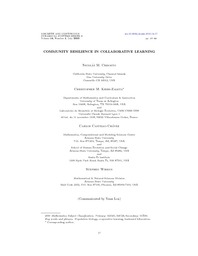
ATTENTION: The works hosted here are being migrated to a new repository that will consolidate resources, improve discoverability, and better show UTA's research impact on the global community. We will update authors as the migration progresses. Please see MavMatrix for more information.
Show simple item record
| dc.contributor.author | Kribs, Christopher | |
| dc.contributor.author | Crisosto, Nicolas M. | |
| dc.contributor.author | Castillo-Chavez, Carlos | |
| dc.contributor.author | Wirkus, Stephen | |
| dc.date.accessioned | 2014-08-20T20:21:36Z | |
| dc.date.available | 2014-08-20T20:21:36Z | |
| dc.date.issued | 2010-07 | |
| dc.identifier.citation | Published in Discrete and Continuous Dynamical Systems Series B 14(1):17-14, 2010 | en_US |
| dc.identifier.issn | 1553-524X | |
| dc.identifier.issn | 1531-2492 | |
| dc.identifier.uri | http://hdl.handle.net/10106/24547 | |
| dc.description.abstract | This paper introduces a simplified dynamical systems framework for the study of the mechanisms behind the growth of cooperative learning in large communities. We begin from the simplifying assumption that individual-based learning focuses on increasing the individual's "fitness" while collaborative learning may result in the increase of the group's fitness. It is not the objective of this paper to decide which form of learning is more effective but rather to identify what types of social communities of learners can be constructed via collaborative learning. The potential value of our simplified framework is inspired by the tension observed between the theories of intellectual development (individual to collective or vice versa) identified with the views of Piaget and Vygotsky. Here they are mediated by concepts and ideas from the fields of epidemiology and evolutionary biology. The community is generated from sequences of successful "contacts'' between various types of individuals, which generate multiple nonlinearities in the corresponding differential equations that form the model. A bifurcation analysis of the model provides an explanation for the impact of individual learning on community intellectual development, and for the resilience of communities constructed via multilevel epidemiological contact processes, which can survive even under conditions that would not allow them to arise. This simple cooperative framework thus addresses the generalized belief that sharp community thresholds characterize separate learning cultures. Finally, we provide an example of an application of the model. The example is autobiographical as we are members of the population in this "experiment". | en_US |
| dc.description.sponsorship | National Science Foundation (NSF Grant #DMS-9977919); National Security
Agency (NSA Grant #MDA 904-00-1-0006); Sloan Foundation: Cornell-Sloan
National Pipeline Program in the Mathematical Sciences; the Office of the Provost
of Cornell University; Los Alamos National Laboratory (T-Division); and the Office
of the Executive Vice President and Provost of Arizona State University. | en_US |
| dc.language.iso | en_US | en_US |
| dc.publisher | American Institute of Mathematical Sciences | en_US |
| dc.subject | Population biology | en_US |
| dc.subject | Cooperative learning | en_US |
| dc.subject | Backward bifurcation | en_US |
| dc.title | Community resilience in collaborative learning | en_US |
| dc.type | Article | en_US |
| dc.publisher.department | Mathematics Department, University of Texas at Arlington;
Department of Curriculum and Instruction, University of Texas at Arlington;
Laboratoire de Biometrie et Biologie Evolutive, UMR CNRS 5558
Universite Claude Bernard Lyon 1, France | |
| dc.identifier.externalLink | http://www.aimsciences.org/journals/displayArticles.jsp?paperID=5139 | en_US |
| dc.identifier.externalLinkDescription | The original publication is available at the journal homepage | en_US |
Files in this item
- Name:
- community resilience.pdf
- Size:
- 430.6Kb
- Format:
- PDF
- Description:
- pdf
This item appears in the following Collection(s)
Show simple item record


